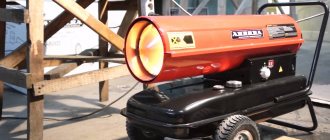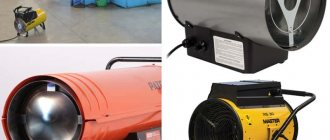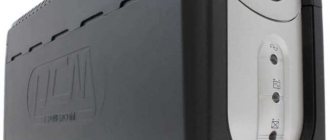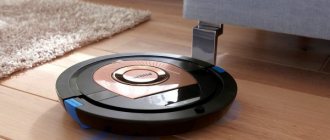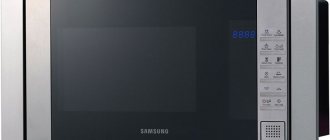How does a fan work?
The essence of the fan's operation is to move air using curved blades directed in a certain direction. Depending on the engine power, the blades rotate along the axis with the appropriate force, pushing away the air flow, and is intended not only for everyday use, but also for cooling various devices and equipment.
Fan device
There are many types of fans, but almost all of them have the same design. The blades are mounted on a shaft, which rotates using an electric drive. The blade and motor sizes vary according to the purpose of application. In everyday life, the diameter of the blades usually reaches 40-50 mm; in industry, the dimensions can range from 1 to 3 m. During the blowing process, the blades capture air and push it along the axis.
Does the fan cool the air?
A household fan does not cool the air, but only creates wind. Even if it works for days, the air in the room will not cool. A person purposefully directs it in his direction to feel the wind blowing. In the heat, increased sweating appears on the body, which takes away excess heat, and the fan simply speeds up this process.
How does the fan switch sensor work?
Devices with motion sensors are more often used in offices. The essence of their work is as follows: a sensor with an infrared eye is located proportionally to the axis, which reacts to movement. As soon as a disturbance is created, the drive starts immediately. As a rule, such fans differ from standard ones in price. If you buy a cheap device with a power sensor, then most likely the fan will not work correctly, will not always respond to movement and will turn off.
How does a fan without blades work?
First, a high-speed motor draws air through a grille at the base of the “leg” body. Then this air is forced into the blower channel (inside the “ring” housing).
The shape of the ring from the inside is, in fact, designed on the same principle as an airplane wing. Therefore, when air moves inside the channel, its speed increases.
The air exits the channel from the narrower side. As a result, an area of low pressure is formed from the opposite, wider one. Thanks to this, the ring itself begins to “draw” air into itself and throw it out from the wide side.
The volume drawn in and expelled due to the pressure reduction effect is 15-20 times greater than the original volume drawn in by the engine. Bladeless fans are capable of passing through up to 500 liters of air in 1 second. So the device “blows air” over everything nearby, without any blades - simply due to the laws of aerodynamics.
What types of fans are there?
Depending on preference or location, there are fans that not only differ in power and blade diameter, but they also differ in shape. Floor-standing devices are more popular because they are the most practical and powerful. Tabletop ones will supply air to a small area, and ceiling ones, although considered the most effective, have a complex design and installation.
Floor-standing
This type is the most common in everyday life. They consist of legs, a stand and a main air supply structure. Their practicality lies not only in their ease of movement, but also in their ease of assembly. Budget models are equipped with several speeds and the ability to adjust air flow. In more expensive devices you can see an LCD display with a timer, time and air temperature, as well as control using a remote control. However, in some cases this can be considered a disadvantage, since more electricity is consumed.
Tabletop
Floor-standing models are intended for individual use, as they cover a small airflow radius. More often than not, they do not have any additional features to increase comfort. Several speed modes and a power off button.
Ceiling
Efficient but not practical fans. They usually come with an installation, for installation on the ceiling or in a chandelier structure. Another disadvantage is the high cost. But this device has more advantages:
- large area coverage;
- large blades;
- rapid cooling of the room;
- does not take up space in the room.
Duct
Duct fans operate on the same principle as floor or table fans, but they are designed to extract air. In appearance, such devices resemble a pipe with blades inside. In everyday life, they are installed in the kitchen or bathroom to eliminate odors and excess moisture. In industry, they also extract air from indoor spaces, be it a factory or a store.
Other types of fans
Depending on the design and purpose, fans can be floor, table, wall, ceiling or duct, as well as roof.
So the simplest example of apartment ventilation is the use of table or floor type.
They, as a rule, do not have a guide body and serve only to mix the air masses in the room.
Ventilation of apartments is slightly more effective when fans are installed in window openings, vents or special openings in the wall. At the same time, they work to remove air from the room, and the supply of fresh air occurs due to natural infiltration - the flow of air through leaks in building elements.
If air is only removed from the room and replaced with new air naturally, ventilation is called exhaust ventilation. Otherwise, when air is forced into the room using a ventilation system, ventilation is called supply ventilation.
Typically, handling unit uses an air duct system to supply fresh air . The supply unit allows for the intake of fresh air, its pre-treatment (filtration, heating or cooling, humidification or dehumidification) and transportation to the room. The simplest design of the air supply unit consists of a housing, a fan, a filter and a heater (electric heater).
Ventilation of apartments is most effective and optimal when the volumes of exhaust and supply air are balanced. That is, both the supply unit and exhaust ventilation operate simultaneously with the same performance. Such systems are called supply and exhaust systems.
Based on their design, fans are divided into multi-zone, duct and roof fans.
A distinctive feature of multi-zone ones is the housing, which allows you to connect several air ducts at the same time. Multi-zone type is indispensable in facilities where air exhaust (or vice versa, its supply) must be done from several rooms at once. Their use makes it possible to optimize air duct networks and reduce the cost of operating the entire ventilation network as a whole.
Duct fans are the most common type of equipment for installation in ventilation ducts of round and rectangular sections. They can be either axial or radial type. Having small dimensions, they can be mounted directly in the cross-section of air ducts.
Rooftops, by definition, are intended for installation on the roofs of buildings. Due to more severe operating conditions (precipitation and constant wind loads), their body is made on a reinforced frame made of anti-corrosion materials - galvanized or galvanized steel, protective epoxy coatings, etc. They can be used both to solve problems of general ventilation and local ones, which include ventilation and exhaust of fireplaces, stoves, gas boilers and similar equipment.
Each type of fan, depending on the requirements placed on it and operating conditions, may have additional design features - fire protection, increased resistance to vibration, reduced noise characteristics, for smoke removal, made from materials suitable for aggressive or dusty environments, etc. .
Types
In addition to different types of designs, fans are divided into types that differ in the process of air supply. Axial ones are used most often in everyday life, since their cost is lower than that of their analogues. Radials come in second place in popularity. Bladeless models are rare to find because they are expensive due to their complex design.
Axial
The operating process of the device consists of axial movement of the blades using an electric drive. This option is most common in everyday life due to its low cost and practicality.
Radial
The column-shaped device has a built-in special cylinder with blades that squeezes out air under pressure. This mechanism is quieter compared to the axial one, and takes up little space. Some models are equipped with a 360 degree airflow radius.
Bladeless
A bladeless fan blows air into the room using a turbine. Air is sucked in by the device and squeezed out with high pressure. Due to its complex design, it is more expensive than its analogues, but it is the safest due to the absence of blades.
Which fan to choose for your home: criteria
Diameter, material and number of blades
Depending on the area of the room, you need to choose the appropriate diameter of the blades. For an ordinary apartment, standard sizes will be sufficient - 40–50 cm. The larger the blades, the larger the radius of air coverage.
The number of blades affects the speed of air flow. If you choose a model with more blades, then the air will be supplied more strongly, but such devices consume more energy and affect the longevity of the electric drive.
On budget fans, the blades are made of flexible plastic; in the case of expensive models, the design can consist of both plastic and metal. These characteristics do not affect the quality of the air supply.
Power by room area
The more powerful the fan, the more massive and further it pushes the air. This parameter is more relevant to exhaust duct devices. There is a conditional rule by which the appropriate fan power is set. We measure the area of the room horizontally and vertically, and multiply the resulting amount by 4. The final figure will indicate the power requirements of the device.
For a floor structure, square meters are calculated, since only the horizontal area where air circulation will occur will be involved in the process. The power of conventional models usually does not exceed 50 W.
Performance
Productivity is usually measured in cubic meters. You can see these characteristics in the device passport. The calculation is based on the area and the regular number of people present. For a room 8x10 m, a fan with a blowing area of 50 m will be enough.
Number of speeds
This function is found in almost all fans. In budget models, up to 3 speeds are installed, in expensive ones you can see 7 transitions. Switching speeds affects the speed of the blades. This is a convenient feature that will allow you to adjust the air flow depending on the temperature in your home.
Air strike
This term indicates the distance a fan is capable of blowing. The characteristics directly relate to the drive power and the density of the blades on the axis. The air strike parameters are also indicated in the passport. If your room is small, then 40–60 cubic meters is quite suitable for a floor fan, and 20–35 for a desktop unit.
Air exchange
Such a characteristic as air exchange refers to duct exhaust devices. Here you will also have to calculate the area of the room and compare it with the characteristics in the passport. This is determined by the multiplicity in hours. That is, how many times in an hour the air in the room will completely change. Let's take standard indicators:
- kitchen – 5–12 times per hour;
- bathroom/toilet – 5–9 times;
- bedroom – 3–7 times.
For the optimal ratio, measure the cube. area and multiply it by the standard air exchange characteristics of the corresponding room.
Airflow area
This characteristic applies to floor and tabletop models. Its value indicates the area that the fan can blow. Standard models cover an average of 40-50 m, but if you have long or large rooms, then it is better to look at a more expensive fan, otherwise the air will not reach the other end of the room. The blowing area directly depends on the engine power.
Tilt and rotation angle
Almost all modern fans are equipped with rotary axes, the only difference is in the degrees of rotation. The most common models are those with a horizontal rotation of 180 degrees, but you can also choose 45 and 360 degrees. This characteristic will largely depend on the cost of the fan. The automatic rotation function only works in the horizontal position; you will have to adjust the vertical position yourself.
Noise level
Check the noise level immediately before purchasing. Let the consultant unpack the fan and start it up, switching the blowing speeds. The standard quiet value should not exceed 40 dB. If you will turn on the fan in the bedroom, then choose a model with a noise level of no more than 30 dB.
Airflow mode
The indicator directly depends on the number of blades. Different types of fans can have from 2 to 10 blades on the axis. Accordingly, the device will blow air over the area depending on the rotation speed. There are models with automatic air flow changes, they are called climatic. According to customer reviews, this mode is not very useful.
Control block
Standard fans usually have 4 buttons: 3 speeds and stop. You can also see the backlight button, however it does not shine on the panel or fan blades, this switch indicates the exact location of the device in the dark. Expensive models are equipped with displays that show the flow rate, room temperature, clock and shutdown timer.
Remote control
Using the remote control, you can adjust the fan settings without going near it. This is not to say that this is an important function, but it is relevant for older people. There are remote controls with LCD displays, with which you can also adjust the device settings.
Timer
Models with a display have a countdown timer that allows you to set the on and off times. It is convenient to activate the function before going to bed.
Ionizer
Air ionization has a positive effect on the human body. With the help of aeroions, you will sleep better, become more active and speed up your metabolism. The ionizer also draws in harmful oxygen elements, purifying it from dust and gases.
Humidifier
The humidifier is sold as a separate device, but it can also be integrated into the fan itself. For this function, a corresponding fluid tank is located on the structure. The big advantage of using a humidifier is that the released moisture will be blown out along with the air, taking up a large area of the room. Expensive fans have an indicator indicating the water level in the tank.
Adjustable
Control of conventional fans is based on a panel with buttons. With their help you set the flow rate or timer. In the list of expensive models you can see an automatic regulator that will monitor air temperature, humidity and pressure. The built-in sensor will automatically start or turn off if the humidity or temperature levels go beyond certain limits. The high cost of such models is due to their complex design.
Protective grille
The blades of each floor axial fan must be protected with a mesh. It can be made of either metal or rough plastic. As for table fans, in some models this factor is not necessary, since due to the low power and small blades, the chance of knocking it over is insignificant. However, choose better protected models, regardless of the type, as the device can catch hair or accidentally injure you.
Sustainability
Floor fans come in different designs. Usually the rack lies “crosswise”, secured with bolts. Desktop devices have different mounting options. Designed specifically for the monitor, they are attached using a special clothespin, but there are also devices with suction cups.
Certificate
Before purchasing a fan, ask your consultant for a passport and quality certificate. Typically, the documents describe the device parameters and the level of assembly guaranteed by the manufacturer.
Which fan is better, column or blade?
A blade fan operates using a simple mechanism - an electric drive rotates the blades along an axis, which creates an air flow. The column structure operates according to a more complex mechanism - air under pressure is released into the atmosphere. During operation, a column fan is quieter than a blade fan. Another advantage is increased safety, since the blades are located in the housing.
Blade fans are more common because they are inexpensive. Compared to radial ones, their design is more simplified. But it is worth noting that in brand stores even floor-standing models can be equipped with powerful, silent drives and many functions. The choice of fan will depend entirely on your preferences and budget.
Axial or axial
In appearance, a fan of this type is a metal casing in the form of a cylinder, where there is a wheel with blades of different configurations, mounted on the same drive shaft. The case has special perforations for reliable fastening at the place of use. The air flow is parallel to the axis of rotation. A collector is located at the inlet - it improves the aerodynamics of the product during operation. How the product works can be explained quite simply.
- An electric motor mounted on a special frame spins the fan impeller, mounted on the same shaft as it.
- The impeller speed is identical to the drive parameters set by the manufacturer.
- The blades are attached to the hub in such a way as to capture layers of air and direct them along the axis. The blade span does not have clear gradations: in everyday life they are used with a length of several centimeters, and in industry - up to several meters.
The device is protected by a fine mesh to prevent the entry of objects that could cause damage to the structure and to ensure safety.
The efficiency of axial units is significantly higher than other products; the pressure of the air mass and its quantity can be adjusted by changing the angle of attack of the blades . This type of fan is used to move very large air masses with low counter resistance.
Below is a drawing of an axial fan, where 1 – housing; 2 – impeller; 3 – shoulder blades; 4 – electric motor.
Advantages:
- relatively low energy consumption;
- the mechanism works properly without human intervention;
- installation does not require much space.
Flaws:
- the product works properly only with air without impurities;
- high vibration and therefore noise.
As a rule, such products are installed outside of objects so that the noise of the fan does not interfere with the production process.
Fans with built-in cooling system
Fans with air cooling function do not take up more space. The only difference that distinguishes them from conventional paddle models is the water tank. Its sizes range from 10 l to 50 l. During operation of the fan, cold fog-forming steam is released, which enters the air flow.
Before purchasing this type of device, always check its noise level, as in cheaper models, the steam production, as well as the operation of the blades, can create quite loud noises. For public institutions this indicator is not so important, but when used in everyday life, the increased noise level will cause discomfort.
Errors in selection
Many buyers do not look at the characteristics of fans at all and make a mistake because even expensive models may not only not meet the area ratio, but also be unsafe. Let's look at the main criteria you need to pay attention to when buying a fan:
- Fire safety. First of all, pay attention to the quality of the power cord. A device with a thin cord indicates poor resistance to current and is easily damaged by external objects. It is not recommended to purchase such fans, as they can begin to melt under prolonged load and cause electric shock if the outer sheath of the wire is damaged.
- Current conductivity. Fan designs are mostly made of plastic, but in expensive models you can see a solid metal casing. If you take into account the build quality and stability, then the iron one will be a level more practical, but as far as safety is concerned, the opposite is true. If the power cable is damaged, metal devices will be good conductors of current, which will lead not only to a serious short circuit leading to a fire, but also to electric shock. Never move a running fan around the room!
- Additional functions. Today there are many devices for air cooling, which differ in build quality and the presence of additional functions. If you choose a fan for your home, then you should not overpay for lighting and similar functions. The presence of an LCD display informs about the air temperature and time, but more important will be the built-in timer, which will start or turn off the fan at the time you specify. It is better to choose a device with air purification, as this function will have a positive effect on your well-being.
In addition to safety, pay attention to the noise level. Always test the fan for functionality immediately before purchasing. Carefully inspect the assembly of the structure.
How much does a fan cost?
In every home appliance store you can see many varieties of fans. They all differ in build quality, technical parameters and functionality. Many buyers often choose Chinese models, which according to advertising have high quality and a huge list of features. In reality this is not the case at all. According to statistics, cheap Chinese fans break down after just a few months, the reason for this is poor wear resistance, and this applies not only to the design, but also to the electric drive.
It is recommended to buy branded models, as they have already proven themselves in quality and performance. In case of problems or breakdowns, devices of a famous brand can be taken to a service center, which is located in almost every city.
A budget blade fan costs an average of 1,200 rubles. It consists of plastic and metal. Functionality may include backlighting and 3 air flow speeds. By purchasing a model for 3000 rub. and more, think about a radial device, since it makes virtually no noise, takes up little space, and is safe due to its design.
The cost of a duct fan will depend directly on its power. The average price of such models is 3000 rubles. For larger areas, you will need to allocate more funds to ensure the strength and shape of the structure meets the requirements.
Bladeless fans are more commonly used as desktop cooling devices. Their cost ranges from 400 rubles. up to 25,000 rubles, depending on power and brand.
Centrifugal fans
The simplicity of the design of centrifugal fans allows them to provide enormous performance and good air pressure. And their simplicity guarantees their reliability in very difficult conditions.
Structurally, a centrifugal fan consists of several important functional units:
- engine;
- air pumping system in the form of a flat wheel with blades;
- a housing that not only acts as a supporting structure, but also forms air circulation.
The entire structure is covered with an additional shell. It serves as a soundproofing casing. It is usually lined with sound-absorbing material.
The air pumping system is a flat wheel. It consists of a pair of disks. One of them is solid, it is connected to the engine. The second one has a large central hole. The disks are connected to each other along the perimeter by blades. When they rotate, they form a flow of air directed outward of the wheel.
The working fluid is taken through the central hole of one of the disks. Depending on the configuration and shape of the blades, pumps are capable of:
- work with solid flow components, models do not have disk elements;
- move air with a low content of solid impurities, single-disc solutions;
- work with clean air, in a wide range of output volumes and pressures, classic double-disc models.
Triple disc pumps have two blade areas. Such models, by reversing the engine, are capable of pumping the working fluid in two directions.
How it works
The operation of a centrifugal fan can be described quite simply.
- When the device is turned on, the engine begins to rotate the impeller.
- The air between the blades begins to move outward under the influence of centrifugal force.
- A low pressure zone is formed on the inside of the impeller.
- Air from outside, under the influence of a pressure difference, enters the center of the wheel.
- The movement of air to the edge of the impeller ends at the boundary - the wall of the housing. Here the kinetics of the working fluid is converted into pressure.
- The air pressure generated by the paddle wheel forces the latter through the outlet pipe.
Such a simple operating scheme determines the reliability of the design solution of the centrifugal fan. Today it is found everywhere in ventilation systems, to maintain the shape of outdoor inflatable attractions, and in schemes for removing dust and other particulate matter from the air.
Types of blades
Depending on the blade configuration, the pump may have different performance characteristics. These are not only output technical parameters in the form of pressure and volume of air pumping. By using certain blade configurations, engineers achieve a reduction in the weight and size of the pump and the noise level.
- Back-curved blades prevent dust from accumulating inside the fan and are well suited for air with high levels of impurities.
- The forward curved blades pump the maximum amount of air, the pump is able to provide high pressure.
- The simplest type of blades is straight radial. They are used in low-pressure pumps and have a low noise level. To protect against erosion, the blades are treated with special compounds.
Expensive or cheap, what's the difference?
Cheap models are equipped with standard features. Their design is quite simple - a mount, a leg, an electric motor and blades. If you compare them with expensive fans, the difference can be both in performance and in the number of additional functions. In addition to low noise and a powerful drive, the device can be equipped with an LCD display that will indicate the air temperature and time. These indicators are not vital, but increase comfort. The situation is similar with the remote control.
There are also useful features, such as air ionization or automatic shutdown when there is smoke or a short circuit. All these characteristics are described in the device passport and significantly affect its cost.
The choice of fan depends on your preferences. Choose the model that suits you best. Check the functionality of the device right in the store, carefully inspect the assembly to ensure that the structure is securely fastened.
Do not believe the advertisements of unknown companies that offer innovative technologies at a low cost. Use the Internet to obtain information about a particular fan model, and then you can choose a high-quality cooling device.
Radial fans
The main area of application of radial fans is operating conditions with high pressure in the ventilation system. The main technical characteristics of a radial fan are determined by the geometry of the impeller and blades.
If the blades are curved backwards, the noise level is maintained at 80% efficiency, but the amount of air supplied by such blades is highly dependent on pressure.
This blade configuration is not recommended for dusty air, and the operation of such a fan is most effective in a narrow spectrum lying on the left side of the graph curve (see below).
If the fan blades are straight and tilted back, 70% efficiency can be achieved. This type of fan is well suited for working in polluted air conditions.
If the impeller blades have a straight radial design, then the fan is even less susceptible to the adhesion of pollutants from the air, and at the same time maintains an efficiency of 50% or more.
When a fan is designed with forward curved blades, the fan retains 60% efficiency, however, the increased air pressure has a slight effect on its performance, and this design allows it to fit into smaller overall dimensions, which has a beneficial effect on the weight of the fan and the possibility of its placement.
